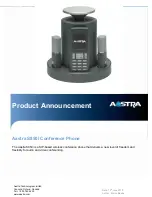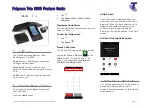
Understanding The T1/PRI Alarms And Indicators
Most of the T1 alarms and indicators (LEDs) are located on the front-edge panel of the T1/PRI board, while
several are located on the front edge of the DXOPT-SYN card. The following sections discuss the alarms and
indicators.
NOTE: Red /Yellow LEDs, when lit, indicate errors or non-standard configuration for normal operation.
T1/PRI Board Indicators
Red Alarm (red LED)
When this LED indicator is lit, the system cannot establish communications with
the network.
Yellow Alarm (yellow LED)
The yellow alarm is lit whenever the far end has lost synchronization to its
incoming signal. This alarm indicates a transmit problem..
Sync Alarm (red LED)
This LED (labeled SYNC LOSS), when lit, indicates that the frame bit in the
received data cannot be found. this alarm indicates a receive problem.
Signal Alarm (red LED)
The signal alarm (labeled SIG LOSS) turns on to indicate that the DXP Plus has
lost its incoming signal. This alarm indicates a receive problem.
Blue Alarm (red LED)
When this alarm indicator is lit, the alarm indication signal (AIS) consisting of
all one (1) bits is being received to indicate that the far end has lost its received
signal. The purpose of this signal is to maintain the system clocks during a link
failure. This alarm indicates a transmit problem.
Bipolar Alarm (red LED)
The system converts the digital bit stream in T1/PRI communications to a bipolar
format through a process called alternate mark inversion (AMI). The voltage
polarity of the ones pulses (marks) alternates between plus and minus with a zero
(space) represented by no pulse. A bipolar violation occurs whenever two
successive pulses are of the same polarity. This alarm LED indicates a bipolar
violation (BPV) has occurred. It is important to note that BPV errors are not
passed through regeneration points. This alarm indicates a receive problem.
Cyclic Redundancy
Check (red LED)
The cyclic redundancy check (CRC) indicator turns on whenever there is a
discrepancy in the check sum received for an incoming frame from the
originating system and the locally calculated check sum. This discrepancy
indicates a data error in the received frame. The CRC is enabled by DIP switch
SW2-4. This light indicates a receive problem.
Slip (red LED)
This indicator is turned on whenever a frame slip is detected. This is caused by
the transmit clock not being synchronized with the receive clock. This light
indicates a synchronization problem.
Unlock (red LED)
The transmit frequency (1.544 Mhz) is not locked with the receive clock when
this indicator is lit.
B8ZS)/COFA (green LED)
This is a dual-purpose indicator. Depending on how you set DIP switch SW2–6,
this indicator reports either a change of frame alignment (COFA) at
re-synchronization time (default setting) or bipolar 8-zero substitution (B8ZS)
code words detected in the received data.
RLB, LLB, and
PAYL (red LEDs)
Whenever a loop back routine is active, either the remote loop back (RLB), local
loop back (LLB), or payback loop back (PAYL) mode (selected by DIP switches
SW2-7 and SW2-8) is indicated by the appropriate LED being lit.
IMI89–255
Installing And Programming The DXPRI Card
32 – Understanding The T1/PRI Alarms And Indicators
















































